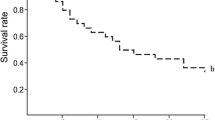Abstract
Capture efficiency, handling time and functonal response to prey density were studied in larvae ofSyrphus ribesii (L.) andS. corrollae (Fabr.) eatingMyzus persicae Sulz. at 20°C, 16 hrs light.
First instar larvae ofS. ribesii had distinctly higher capture efficiency than 1st instar larvae ofS. corollae, both versus 1st instar and adult aphids. Second and 3rd instar larvae of both species seemed to prefer adult rather than 1st instar aphids, but no distinct difference in capture efficiency between the species was found. On comparable stages,S. ribesii always had shorter handling time thanS. corollae and it appeared in both species to be correlated with size of prey and predator. Handling time was thus shortest when 3rd instar larvae consumed 1st instar aphids.
During one hour, 3rd instar larvae ofS. ribesii consumed aphids in quantities almost linearly dependent on aphid density (5, 10, 20 and 40 adult aphids/100 cm2), although the response also could roughly be described byHolling's “basic functional response curve”. On the contrary, 3rd instar larvae ofS. corollae soon reached a maximum consumption during one hour, being almost constant (5–7 aphids) at prey densities ≥10 aphids/100 cm2.
Résumé
L'efficacité prédatrice (proportion de toutes les rencontres entre larves de syrphes et pucerons se terminant par la capture et la succion de pucerons), la durée d'activité et la relation entre l'absorption de nourriture et la densité des proies (5, 10, 20 et 40Myzus persicae Sulz. aptères au 5e stade larvaire/100 cm2) ont été étudiées chez des larves deSyrphus ribesii (L.) etS. corollae (Fabr.) à 20°C et 16 h de photopériode. Les L1 deS. ribesii présentent une efficacité prédatrice des pucerons des premier et dernier stades nettement plus élevée que les L1 deS. corollae (S. ribesii: 71 et 38%;S. corollae: 42 et 0%).
Chez les larves des 2e et 3e stades, on n'a observé aucune différence d'efficacité prédatrice entre les 2 espèces, mais une préférence pour les pucerons adultes.
La durée d'activité deS. ribesii est dans tous les cas plus courte que celle deS. corollae pour un même stade de larves et de pucerons. Une corrélation positive semble exister entre la taille des proies et celle des prédateurs. La durée d'activité est la plus courte pour des prédateurs en L3 s'alimentant de pucerons au premier stade (1,3 mn chezS. ribesii et 2,3 mn chezS. corollae). L'absorption de nourriture enregistrée en une heure chezS. ribesii varie presque linéairement avec la densité des pucerons; elle correspond d'autre part assez bien à la formule deHolling. L'absorption de nourriture parS. corollae atteint un maximum de 7 pucerons à l'heure et demeure pratiquement constante à partir d'une densité≥10 pucerons/100 cm2.
Similar content being viewed by others
References
Benestad, E. — 1970. Laboratory experiments on the biology ofSyrphus corollae (Fabr.) [Dipt., Syrphidae]. —Nor. Entomol. Tidsskr., 17, 77–85.
Blackman, R. L. — 1965. Studies on specificity inCoccinellidae. —Ann. appl. Biol., 56, 336–338.
— — 1967a. The effects of different aphid foods onAdalia bipunctata L. andCoccinella 7-punctata L. —Ann. appl. Biol., 59, 207–219.
— — 1967b. Selection of aphid prey byAdalia bipunctata L. andCoccinella 7-punctata L. —Ann. appl. Biol., 59, 331–338.
Dixon, A. F. G. — 1959. An experimental study of the searching behaviour of the predatory coccinellid beetleAdalia decempunctata (L.). —J. anim. Ecol., 28, 259–281.
— — 1970. Factors limiting the effectiveness of the coccinellid beetle,Adalia bipunctata (L.), as a predator of the sycamore aphid,Drepanosiphum platanoides (Schr.). —J. anim. Ecol., 39, 739–751.
Dixon, A. F. G. &Russel, R. J. — 1972. The effectiveness ofAnthocoris nemorum andA. confusus [Hemiptera: Anthocoridae] as predators of the sycamore aphid,Drepanosiphum platanoides. II. Searching behaviour and the incidence of predation in the field. —Entomol. exp. appl., 15, 35–50.
Hassel, M. P. — 1966. Evaluation of parasite or predator responses. —J. anim. Ecol., 35, 65–75.
— — 1968. The behavioural response of a tachinid fly (Cyzenis albicans (Fall.)) to its host, the winter moth (Operophtera brumata (L.)). —J. anim. Ecol., 37, 627–639.
Holling, C. S. — 1959. Some characteristics of simple types of predation and parasitism. —Can. Entomol., 91, 385–398.
— — 1961. Principles of insect predation. —Annu. Rev. Entomol., 6, 163–182.
Hågvar, E. — 1972. The effect of intra-and interspecific larval competition for food (Myzus persicae) on the development at 20°, ofSyrphus ribesii andSyrphus corollae [Diptera, Syrphidae]. —Entomophaga, 17, 71–77.
— — 1973. Food competition in larvae ofSyrphus ribesii (L.) andSyrphus corollae (Fabr.) [Dipt., Syrphidae]. —Nor. Entomol. Tidsskr., 20, 315–321.
Solomon, M. E. — 1949. The natural control of animal populations. —J. anim. Ecol., 18, 1–35.
Sylvester, E. S. — 1954. Insectary life history and apterous instar morphology ofMyzus persicae (Sulzer) [Homoptera, Aphidae]. —Ann. entomol. Soc. Am., 47, 397–406.
Author information
Authors and Affiliations
Additional information
The author wishes to thank techn. ass.Bodil Horgen for assistance during the experiments
Rights and permissions
About this article
Cite this article
Hågvar, B. Effectiveness of larvae ofSyrphus ribesii andS. Corollae [Diptera: Syrphidae] as predators onMyzus persicae [Homoptera: Aphididae] . Entomophaga 19, 123–134 (1974). https://doi.org/10.1007/BF02373272
Issue Date:
DOI: https://doi.org/10.1007/BF02373272




